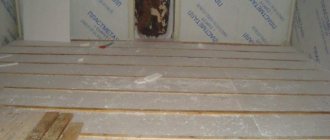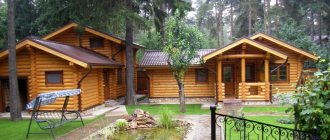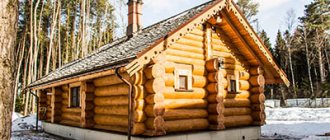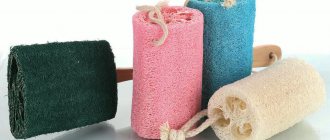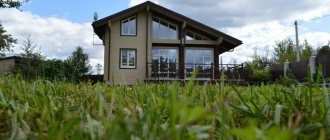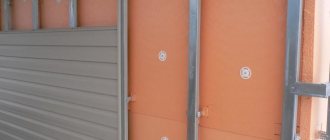What is required from a bath insulation?
If you have already answered your question: “to insulate or not to insulate a bathhouse” in favor of “insulate”, you will have to conduct a serious study of the insulation materials existing today, their characteristics, prices and ease of working with them, study reviews about them. Find out which one Suitable for floors, which is suitable for walls and ceilings.
First, let's consider the main tasks that thermal insulation material for a bath faces:
- Resistance to high temperatures - the bathhouse is a zone of high temperatures and the heat insulator should not lose its qualities when interacting with them;
- Non-toxicity - under the influence of all factors in the bathhouse, the insulation should not emit substances that have a harmful effect on the human body;
- Moisture resistance - the thermal insulator should not absorb moisture, and also should not lose its insulating properties in conditions of high humidity;
- Durability - you are unlikely to want to replace insulation more often than necessary;
- Environmental friendliness - insulation should not contain substances that interact poorly with the human body or have a harmful effect on human health;
- Price-quality ratio - this is how it is now customary to evaluate any product on the market, no matter what it relates to.
Brief overview of existing materials on the market
In the old days, it was customary to insulate baths with various natural heat insulators - tow, jute, felt, moss. But the use of these substances is fraught with the appearance of various kinds of insects, mold, fungi, and dampness. In today's construction, there are a number of new generation thermal insulators that can be used for insulation. Reviews about modern insulation systems speak for themselves.
Penoplex is extruded polystyrene foam. A modern material consisting of air and foamed polystyrene. Due to the combination of its properties, it is very popular as a thermal insulator for various rooms. In a bathhouse, it can be used to insulate the floor, as well as all rooms except the steam room.
Basalt wool is a modern insulation based on basalt volcanic rocks. 90% consists of air. It has very high heat resistance and is completely non-hygroscopic. It is resistant to high temperatures, highly environmentally friendly and absolutely non-flammable and non-toxic. It can be used for thermal insulation of the ceiling and walls in a steam room.
Expanded clay is a modern insulation material that can be successfully used to insulate the floor of a bathhouse. Also, to insulate the ceiling, a method is used when the attic is filled with expanded clay. It is obtained by firing natural intumescent clays, which gives it its special porosity. Excellent thermal and sound insulator. The bulk substance is produced in the form of oval granules of various sizes. It has an extremely low specific gravity, which makes it indispensable when it is necessary to reduce the load on the structure. It is added to concrete, thus “diluting” its excess weight. Perfectly absorbs excess moisture.
The list of possible insulation materials is impressive and we present only a few, especially popular ones.
Main characteristics of penoplex
Each of the above materials is good for its tasks and its areas when insulating a bath. Some materials are suitable for floors, others for walls and ceilings. Some can even be used in a steam room, others are recommended to be placed in all bath rooms except the steam room. Let's take a closer look at penoplex as insulation for a bathhouse floor.
Reviews about it are very favorable. We can say that today penoplex is one of the most used thermal insulators both for baths and for any other types of premises. This happens due to the combination of its following qualities:
High thermal insulation properties;
- Environmental friendliness;
- Moisture resistance and heat resistance;
- Non-toxic;
- High resistance to compressive loads (which is important when insulating the floor);
- Light weight (which makes it easy to install);
- Well amenable to mechanical processing;
- Resistance to mold and mildew;
- Resistance to temperature changes;
- Affordable price;
- Durability.
The disadvantages of expanded polystyrene include the following:
- Has low strength;
- When burned, it emits highly toxic smoke, which can cause serious damage to health or even death;
- Destroyed by some chemical solvents.
As we can see, the list of useful qualities of penoplex largely corresponds to the above list of necessary characteristics of insulation for a bathhouse. It can successfully insulate the floor in a steam room. It is also ideal for thermal insulation of walls and ceilings in all rooms except the steam room. Insulating the ceiling and walls in a steam room with penoplex is not recommended - its properties are lost at temperatures from -50 degrees to 75 degrees Celsius.
To insulate walls, steam penoplex can only be used if a foil layer is placed behind it, protecting it from exposure to excessively high temperatures. Thermal insulation of the steam room ceiling with polystyrene foam is categorically not recommended - the material may come into contact with the pipe, which heats up to 200 degrees Celsius, which can create a fire hazard. Therefore, for these tasks, as a rule, basalt wool is used, which is an absolutely non-flammable material.
Main features of the material
Penoplex is essentially a polymer substance with a foamy texture. It is produced by extruding ordinary polystyrene. The use of the most advanced equipment allows us to obtain a material with a strictly ordered structure. In it, small gas bubbles are distributed as evenly as possible. Such pores have a diameter of 0.1 to 0.2 millimeters, they are completely closed and insulated. The foaming component of the material is lightweight varieties of freon, to which carbon dioxide is added. The resulting material is chemically inert, that is, it does not enter into chemical reactions. This eliminates the possibility of the development of processes of rotting or oxidation of the insulation.
It is no secret that the thermal insulation qualities of any material with a foam or porous structure can be significantly reduced in the presence of high humidity. This property is not typical for penoplex. The material slightly absorbs moisture during the first 7 or 8 days, while the pores near the surface of the material are filled. Then the moisture absorption process stops. Thus, the thermal insulation qualities of penoplex practically do not change. In addition, the insulation is completely impermeable to water vapor, which is important in a bathhouse.
There are three types of material:
- Penoplex marked 35.
- Penoplex standard.
- Penoplex-45.
Each variety differs from others in terms of specific density, mechanical strength and thermal efficiency. To insulate floors in bathhouses, the first two types of penoplex are used.
Penoplex insulation, marked 45, has an increased level of mechanical strength and can be used to insulate floors exposed to mechanical loads, as well as various types of vibrations. The dimensions of a standard slab are 60 centimeters wide and vary in thickness from 2 to 15 centimeters. Sales records belong to insulation with a thickness of 10 to 12 centimeters. The length of the slabs can be 120 or 240 centimeters. For large objects, penoplex slabs are produced in 4 and 4.5 meter formats.
Do-it-yourself internal and external insulation of bathhouse floors
Year after year, the Russian bathhouse does not lose its position in popularity. But it is important to know that such a structure must be built in strict accordance with the rules and regulations of construction work. Largely because of this, the relevance of the issue of bath insulation methods remains high.
List of required tools
When starting to independently carry out work on insulating the floor in a steam room with foam slabs, it is necessary to prepare the following list of devices and various tools for work ahead of time:
- when arranging wooden flooring you will need a grinder;
- electric drill;
- screwdriver;
- knife with a sharp blade;
- scissors;
- construction stapler (furniture);
- paint brush;
- spatulas;
- trowels and other tools intended for concreting and plastering of surfaces;
- roulette;
- shovel;
- metal ruler;
- hammer;
- mallet;
- building level.
Steam room floor insulation
How is a concrete floor insulated in a steam room using penoplex? In the absence of high-quality heat insulation, the concrete floor in the bathhouse will be cold. Penoplex is the type of insulating material that will help solve this issue without unnecessary difficulties. The insulation process will look like this:
- Stage one - waterproofing the foundation pad. Protection against moisture is achieved by applying a special bitumen-based mastic in two layers.
- Stage two is laying an additional waterproofing layer from materials produced in the form of rolls. It can be a well-known and popular roofing material or a thick polyethylene film. There are also more modern types of materials, which include hydroglass insulation, as well as glassine. The insulation strips should overlap each other by 10-12 centimeters.
- Stage three - laying out foam sheets. They must be carefully aligned horizontally. This parameter can be easily checked using a building level.
- Stage four - a special metal mesh is installed to reinforce the surface. You can also use steel wire.
- Stage five - pouring the concrete screed. The mixture diluted according to the instructions is poured into a layer, the minimum thickness of which is 7 centimeters. You can achieve ideal surface evenness by setting beacons. The screed layer is most often formed in such a way that the slope is in the direction of the hole for draining the water.
- The final stage is the installation of the finishing floor covering, which has a decorative function. For a bath room, it is important to use wood flooring or laying ceramic tiles.
Briefly about the technology
Concrete floors
Let's start with concrete. Regardless of which type of insulation you plan to use, the entire process of insulating the floor will look approximately the same. Therefore, the step-by-step guide in my article will be more schematic than educational. However, to any person who is not so far from construction (and I suspect that there are some among the readers of my blog), everything will be clear without small details (which I can cover separately if questions arise).
So, whether you decide to lay foam plastic under the screed or use, for example, glass wool, the stages of work will not differ significantly. The first step is to prepare the base. The soil is thoroughly compacted, with the preparation of the so-called cushion (naturally, all the necessary details for arranging the drain are also provided). We think through the entire sewerage system in advance.
We fill in a rough screed, designed to ensure leveling of the base and ease of carrying out the next steps. After it hardens, a layer of waterproofing is installed (you can also read about this in more detail in other articles on my website).
Now a layer of thermal insulation is laid, the thickness of which depends on the design of your structure (at a minimum, it cannot be thinner than the standard sizes of the sheets of insulation used).
*Separate recommendations for working with perlite
Perlite and vermiculite
First, avoid drafts while preparing the mixture, otherwise your “sand” (which makes up the base) will scatter so much that you will not be able to collect it. Secondly, to make the mixture it is recommended to use cement of at least grade M 400. Thirdly, follow the recommended proportions, which will speed up the hardening of the layer and ensure its maximum efficiency.
After laying the thermal insulation, the main layer of concrete with its indispensable reinforcement should be poured (I also have many articles about the intricacies of this process).
Well, all that remains is to finish this epic (of course, after the concrete has completely hardened) by laying tiles or mosaics. True, there is one more point. If you are making a bathhouse “for yourself” and are ready to invest a little in it, then before laying the cladding, we can recommend installing an “electric heated floor”.
This is essentially the same as installing heated floors in any living space. Infrared film under the tiles is very easy to install, and turning on its heating depends only on your choice and weather conditions (but in severe frosts you will not regret having it). The relaxation room will delight your feet with great pleasure.
Another option is to make a water heated floor. For those interested, here is a link to the article. By the way, this small bathhouse has been in operation for 4 years, and so far there have been no problems with heating the floor or the entire room...
Wooden floors
Now let's talk about wood floors. In general, the technology for insulating them (meaning non-leaking floors) is similar to working with concrete. But there are also some peculiarities:
- Choice of insulation. The ideal option, in my opinion, would be polystyrene foam, which does not allow moisture to pass through (when using other materials, you will have to think carefully about the correct arrangement of waterproofing).
- Preparing the subfloor. I have also written about this more than once in articles on my website. Here you can use low-grade boards that will be attached to load-bearing beams (joists). At the same time, the essence of arranging such a floor will not differ much with different types of foundation. After all, both the strip foundation and the foundation on screw piles, after installing the support beam, turn into an elementary structure, work with which is carried out according to a single technological process.
- Waterproofing membrane. A thin layer designed to protect beams and subfloors from exposure to steam or leaking water. When laying it, you should thoroughly insulate the joints and provide overlaps on the walls (about 20 cm).
Insulation. In general, the principle of its installation is so simple that I won’t even dwell on this point
The only thing I would like to pay attention to is the choice of insulation. Depending on the material used, you may have to install another layer of waterproofing on top of it. The final
All “unflattering” grooves and joints, as well as the space at the outlet of the sewer pipe and drain, can be blown out with foam. After this, feel free to lay the finished floor, not forgetting about the gaps (about 4 cm) between it and the underlying level, which will significantly improve ventilation and will help the floors dry out as quickly as possible.
How to insulate the floor in a bathhouse
They practically don’t think about this, but in vain. After all, warm air rises up to the ceiling, but the floor remains poorly heated. And it’s really unpleasant when it blows and your feet freeze, since the heat evaporates through the floor to the outside. That's why you need to insulate the floor.
How to insulate the floor in a bathhouse with your own hands?
It's pretty simple. You need to select material for floor insulation, find time and resources.
The first thing you need to understand is what material your floor will be made of. Then choose insulation that matches the structure of your bathhouse floor. Well, carrying out work on floor insulation is a matter of technology.
Insulation of frame building walls
They begin to equip the thermal protection of a frame bathhouse building simultaneously with the construction of its walls. The fact is that the use of this technology assumes that the heat insulator is also a structural material. When building a panel bathhouse from insulation with your own hands, its layers are laid out between the load-bearing elements of the frame. A vapor barrier is installed on top of it.
At the end of the insulation work, you get something like a pie, in the center of which there is a heat-insulating material, lined with a vapor barrier on the inside, and waterproofing on the outside.
The outer layer of the cake will be represented by decorative finishing inside the bathhouses, and on the outside - by facade cladding. Both of these layers will not only provide additional thermal protection, but will also serve as a structural element that will enhance the strength of the entire building.
Among professionals, the best option is considered to be laying two layers of heat-insulating material into the bath frame. In this case, it is advisable to make the first of them from tile insulation, and the second from roll insulation. As a result, such a thickness of the walls of a frame bath can reliably protect the premises from heat loss.
How to insulate the floor in a steam room?
Particular attention should be paid to the steam room in the bathhouse. After all, a steam room is a place where it should be quite warm and hot. This is where various bath procedures are mainly carried out. In the steam room (and in the washing department, and often they are combined) there is always high humidity, it is slippery and the floor does not dry out well. Therefore, it is necessary to insulate it properly. The best materials for insulating the floor in a steam room are polystyrene foam or perlite. When you decide to insulate the floor with perlite, you need to do the following:
• lay two layers of concrete;
• a perlite gasket is laid between the layers;
• Allow each layer to dry for a week.
Useful tips
Insulating the floor in a bathhouse with penoplex yourself is a fairly simple task. However, beginners may often encounter minor problems during further operation. Most often, troubles are associated with insufficient calculations in matters of drainage.
A large amount of water often accumulates in the bathhouse. Moreover, this happens not only in the steam room itself, but also in the common room. To prevent the liquid from stagnating, experts recommend making a slight slope towards the drain hole at the stage of laying penoplex.
Each bathhouse requires a drainage system to remove water. The drain hole must be designed in advance and its location taken into account when insulating the floor. Before laying the polystyrene boards, a hole for the sewer is made in the desired location. To make the connection as tight as possible, use acrylic glue or bitumen mastic.
How to insulate a wooden floor in a bathhouse?
Wooden floors have their own characteristics. Moisture from steam or water that gets onto the floor during washing and bathing procedures has a negative effect on the wood from which the floor is made. The wood swells, it begins to rot, it becomes covered with mold, and as a result, the bathhouse itself wears out.
The best option to avoid such an unsightly fate is to choose the right type of wood from which the floor for the bath will be made. Larch wood is excellent because larch easily withstands getting wet. You can choose pine, spruce or fir. But aspen, oak, poplar or linden are completely unsuitable for flooring. These types of wood are not suitable for hot, and most importantly, damp rooms. It is best to insulate a wooden floor with expanded clay, glass wool, mineral wool or slag.
What to consider when buying insulation?
Having weighed all the pros and cons, it becomes clear that insulating a bathhouse with foam plastic is the best option. The amount of insulation you need to purchase will depend on several factors. Firstly, the climate zone: in a warmer climate, much less material will be required than in regions where the thermometer can drop to -20 degrees or below. The material of the walls is also an important factor: stone structures retain heat worse than wooden ones, which means they will require more insulation.
In addition to the material of the walls, the baths differ in type: in addition to the Russian “black” and “white” baths, there are the Finnish sauna, the German “Sanarium”, the Turkish “Hamam” and the Japanese “Ofuro”. Each of them has its own specifics, which must be taken into account when insulating a structure.
Regardless of the type of bathhouse, its geographical location and wall material, foam insulation must be purchased with a slight excess (10-15% of the calculated quantity), the same rule should be followed when purchasing materials for securing the insulation. This approach will allow you to avoid shortages of material in the event of defects or damage that occur during the execution of work.
After you insulate your steam room with polystyrene foam, you will be able to feel from your own experience how much the quality of the bathing procedure has improved, since it will be possible to heat the steam room to 100 degrees and higher much faster than before (the exact time depends on the area of the room). At the same time, much less fuel will be spent on kindling. Owners of bathhouses insulated with foam plastic can only wish for light steam!
How to insulate floors in a bathhouse with expanded clay?
Expanded clay has the main advantage over other insulation materials; it is relatively cheap. Expanded clay is best suited for insulating floors in bathhouses; it can withstand high pressure, up to 320 kg/m2.
To create expanded clay insulation, you need to mix expanded clay varieties; the space of the heat-insulating layer will become denser and will not sag. In general, it is recommended to use the largest varieties of expanded clay from 1 to 4 centimeters.
Expanded clay insulation technology:
• prepare the floor for insulation, clean off the old screed and top layer, level the ground and compact it (earthen floor), the wooden floor must be treated with antifungal agents;
• put a moisture-proof layer of polyethylene film;
• cover with a layer of expanded clay granules, compact and level;
• strengthen with liquid cement mortar, fill it with it;
• let the resulting layer harden;
• fill the floor screed;
• let it dry, this concrete screed can dry out for more than a week;
• finishing and decorative work is carried out.
How to insulate the floor in a bathhouse with penoplex?
Penoplex insulation is performed in the following way:
1. install penoplex insulation boards;
2. lay a hard finishing floor covering on the slabs.
Advantages of penoplex insulation:
• resistance to fungal diseases and mold;
• relevance of use at high temperatures and humidity;
• perfectly saves heat due to its high heat-saving characteristics;
